Insight Focus
European milk production is close to 2023 levels. This hints at a flatter but prolonged peak this year. New Zealand March milk production dipped by 1.24% and while weather favors most dairy regions in New Zealand, breakeven concerns may impact farming strategies.
Prolonged Peak Expected in Europe
While soil moisture in much of Northwestern Europe is good as we enter May, temperatures are warming up and we are seeing soil moisture levels begin to reduce in these key dairying regions.
All three of the major European producers have seen a retracement to their 2023 collections at this same time last year. Germany remains slightly above, France slightly below and the UK now below 2023 and dropping away. Through week 13 of 2024, the group are just 0.02% behind 2023 on cumulative collections and were up 0.22% on aggregate versus the same time last year.
Many believe that Europe will see a flatter but longer “peak” this year. With the actual peak now likely to have passed, we should see this data come in in the next week or so. The expectation is that the aggregate production of this group is now down year to date.

New Zealand Experiences Favourable Weather
The latest milk collection figures for the month of March have been reported by all dairy processors. After a very strong February, New Zealand saw a 1.24% reduction in March this year compared with 2023. New Zealand milk production is now up just 0.80% through this Fonterra Financial Year.
We witnessed a familiar situation this March, with Fonterra down 2.4% while the aggregate non-Fonterra processors were up 3.1%. The non-Fonterra group netted 38.2 million kgMS in March and their market share growth continues to grind upward to over 22% year to date.

New Zealand weather in April was slightly warmer on average (+0.4 degrees) across the country. However, those regions that were significantly warmer than usual were not the main dairying hubs. The Western side of the country saw high rainfall throughout April, while the East has been continually dry. This pattern is very typical of the prevailing El Niño.
This weather pattern has continued to favour most of the key dairy regions. I have annotated the NIWA map below with two circles to highlight the relatively good soil moisture conditions in areas that account for almost 70% of New Zealand’s milk production.

Source: NIWA
With the milk price payout for this season almost fully priced in the high NZD 7’s, many farms will be right at their breakeven. Given the weather dynamic, farms in those dry regions should be expected to dry off early rather than add cost with additional supplementary feed. Those who still have decent grass covers might try to maximize their returns for the 2023-24 season.














